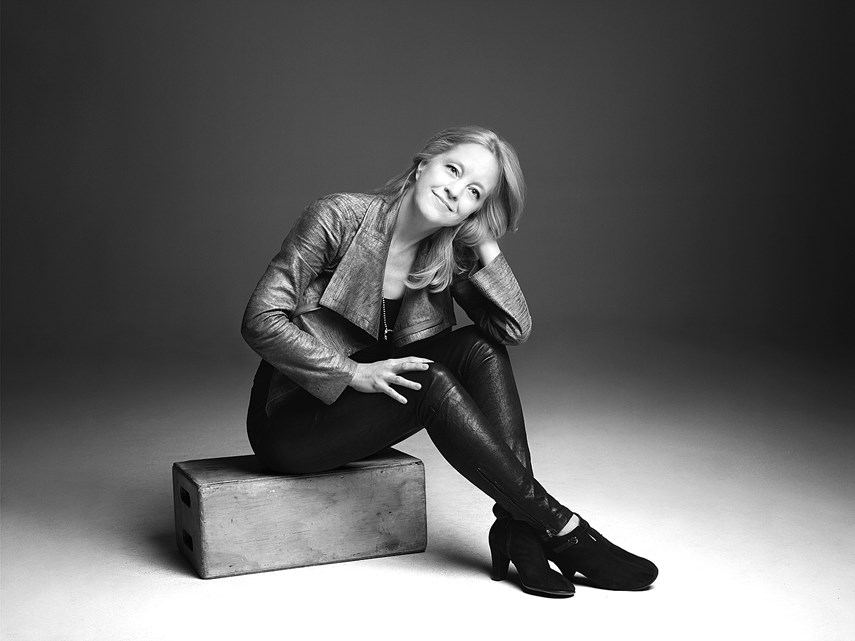Maria Schneider with “A” Band and NiteCap at The BlueShore at Cap U on Friday, Oct. 27 at 8 p.m. Tickets $45/$42. For more information visit capilanou.ca.
Dancers hear music and move. Maria Schneider moves and the music takes shape.
Surrounded by 40 student musicians in a rehearsal room in Capilano University’s Fir building, the acclaimed jazz composer and conductor corrects, cajoles, praises, suggests, interprets, exhorts and listens.
Schneider listens like Sherlock Holmes sees, absorbing and analyzing everything around her, then wondering what else it could be.
When the singers are a bit too boisterous, a student asks if they should sing off-mic.
“Let’s experiment,” she decides.
Many of the students she’s working with today were in Grade 2 when she was receiving plaudits for her breakthrough album Evanescence. She’s won Grammy awards and collaborated with David Bowie but in the rehearsal room she’s humble to the point of self-effacing.
She instructs the singers to seize on the word “cracking,” to evoke the cold described in the lyrics before adding: “This is coming from somebody that has no voice and doesn’t really know anything about it. Just gut.”
When the rehearsal is over Schneider explains the importance of that type of back and forth.
“I think it’s the spirit of jazz,” she says. “That makes me feel like I’m actually making music with people and not dictating.”
Wednesday’s rehearsal is in anticipation of a concert slated to feature the university’s jazz band and vocal ensemble performing a range of Schneider’s work.
She’s been hailed for her music’s inventiveness and complexity, but on stage, none of that should matter.
“I make music to communicate with people,” she says. “I don’t think it’s like inside baseball.”
Discussions in the rehearsal room centre on musical rhythms and textures but there’s also a good amount that comes straight from the gut.
At one point she addresses the lack of excitement in the singers’ voices when they mention a dust devil.
“Have you ever seen a dust devil? It’s frickin’ amazing!” she informs them.
Schneider, much like the crowd at a monster truck show, only uses the edge of her seat. She’s perpetually leaning forward, ready to jump and offer an idea. During my 45 minutes observing, the longest she remained seated during a song was 50 seconds.
Earlier in 2017, Schneider made a speech decrying the treatment of musicians by data giants like Google Play, Spotify, Amazon and YouTube, who she accused of exploiting musicians.
“I do really worry about young people and wonder how the hell they’re going to make a living.”
Much like some of her music is coloured by her love of birds and her hometown of Windom, Minnesota, some of her recent “intense, dark pieces” can be attributed to her fight against Google.
“Anything that you spend your time doing comes out in your music,” she promises.
But any dark undertones are absent from the Fir building as she plays the same piano riff over and over, finding just the right one.
During one song she beckons to the band like a boxer challenging his opponent to come forward and fight.
“This chord should be like a train coming down the track at you,” she calls as her body language imitates a lurching locomotive. “Grab a breath wherever you need.”
At another stretch the musicians sing “coy-o-te.”
Their voices sound good, the notes are right, but something needs to be changed, Schneider assures them, although she stops short of saying exactly what.
But should do “whatever you need to,” to make those sounds feel like the adaptable animal and not a “coy-o-e.”
The students laugh, seeming to know exactly what she means. Part of her technique as a collaborator is to leave a few things unsaid. She doesn’t tell them how to get there, only where she wants them to go.
By being less comprehensive there’s more room for interpretation and creativity, there’s – as Leonard Cohen famously put it – a crack where the light gets in.
“You weren’t doing that before?” she asks the drummer.
“No, no,” he admits, just a bit sheepishly.
“I love that,” she tells him.
Having sat on the advisory board of the Cornell Lab of Ornithology, Schneider only issues a completely definitive statement when flicker birds are mentioned.
“You guys have flickers here,” she tells the group, prompting uncertainty from one of the listeners.
“You do,” she promises. “I heard.”
By necessity, jazz cats are listeners, waiting for that cymbal crash that signals the start or end of their solo.
Schneider pushes for something bordering on group telepathy, calling for the students to “anticipate the notes.”
The approach seems to work as the music gets tighter and better, transforming by bits and pieces into something wholly new.
“Do it with everybody,” she invites. “Let’s see what happens.”



